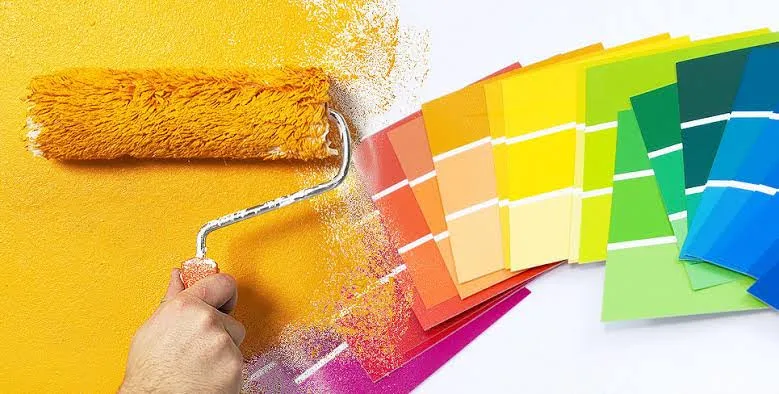Painting Tips for beginners
Whether you’re planning to DIY or get professional painters in, here are some painting tips for you to use or keep an eye out for to give that perfect paint job look!

- Sand
You have to start with a perfectly prepared / smooth surface to end up with perfectly painted walls and wood. Sanding levels out spackle or joint-compound patches and flattens ridges around nail holes. Sanding also removes burrs and rough spots in your trim.
Sand the walls from the skirting to the ceiling with fine-grit sanding paper. Then sand horizontally along the skirting and ceiling. Don’t use a lot of pressure or you could damage the wall. Just aim for a smooth finish.
- Buy The Best
Don’t cheap out on paint and brushes. That cheap plastic brush is going make it look like you smeared paint on the wall with a rake and the bristles will fall out. And get decent quality paint, too. Why? Because it will go on easy and offer the best coverage. It’ll last a long time and you’ll be able to wash a grubby fingerprint off the wall without taking the paint with it. Your whole job will just go quicker and easier.
- Cover Furniture
If you can’t move furniture out of a room, move all of it to the centre of the room and cover / wrap it with plastic sheets that are taped at the bottom. This will not only protect your furniture from paint drips and splatters, but also from all of the dust from sanding.
- Use Primer
Before the pros paint walls and wood, they fill holes and patch cracks with poly-filler / joint compound. However, if you paint directly over it, the compound will suck the moisture out of the paint and give it a flat and dull look. Those spots will look noticeably different than the rest of the wall. To avoid that, pros prime the walls and wood before painting.
- Press Tape
Nothing is more discouraging when you’ve finished painting than to peel tape off the woodwork and discover the paint bled through. To avoid the pain-in-the-neck chore of scraping off the paint, do a thorough job of adhering the tape before you start. Apply tape over the wood, then run a putty knife over the top to press down the tape for a good seal. That’ll stop any paint bleeds.
- Scrape a Ridge
The problem with painting along the edge of textured ceilings is that it’s almost impossible to get a straight line along the top of the wall without getting paint on the ceiling bumps. Pros have a simple solution. They run a screwdriver along the perimeter of the ceiling to scrape off the texture. This lets you cut in without getting paint on the ceiling texture. The screwdriver creates a tiny ridge in the ceiling, so the tips of your paint bristles naturally go into it. You’ll never even notice the missing texture.
- Use Drop Sheets
Pros don’t use bed sheets as drop cloths, and neither should you. Thin sheets won’t stop splatters and spills from seeping through to your flooring.
Use what the pros use— drop sheets. Unless you’re painting a ceiling, you don’t need a jumbo-size sheet that fills the entire room. A drop sheet that’s just a few feet wide and runs the length of the wall is ideal for protecting your floor, and it’s easy to move.
- Finish One Wall
It might seem easy to do all the corners and trim in a room, then go back to roll the walls, but don’t. Pros get a seamless look by cutting in one wall, then immediately rolling it before starting the next. This allows the brushed and the rolled paint to blend together better.
Cover your paint bucket, tray, or container with a damp towel when switching between brushing and rolling to keep your paint and tools from drying out when not in use.
- Scrape Windows
Don’t bother taping windows when painting sashes—it takes a long time and paint usually ends up on the glass anyway. Go ahead and let paint get on the glass. Once it’s dry, simply scrape it off with a razor blade. The paint peels off in seconds. Just be careful to not break the paint bond between the wood and the glass.
- Buy Enough Paint
The “same” colour of every batch of paint can vary. That difference can be glaringly obvious if you buy too little, run out and need to buy more when you’re halfway through a wall. To ensure colour consistency from start to finish, make sure you purchase enough paint from the start.
Some pros then paint directly out of the bucket. This eliminates the need to pour paint into a roller tray, though the heavy bucket is harder to move. Always buy an extra bucket or two.
- Don’t Paint Immediately
If you do not allow 6 to 8 weeks for the salt, alkaline and acid to come through to the surface of newly built / cemented walls, you’re going to have discolouring / peeling paint eventually. Once the salt, alkaline and acid has been given a chance to come out of the wall, you can simply wipe it off and start to paint. That’s the best, and really only, way to ensure your walls don’t discolour / peel paint in the future.
And you also need to make sure that your builder does not “cheapen” the building process by mixing too much sand to his concrete mix, or you’ll have the same discolouring / peeling paint problems.
- Wash
Whether you buy cheap or expensive rollers, washing them before their first use gets rid of the fuzz that inevitably comes off once you start painting. Wash them with water and a little bit of liquid soap and run your hands up and down the covers to pull off any loose fibres. You can start using the rollers right away—you don’t need to let them dry.
- Remove
This is a no-brainer. Instead of laboriously taping or cutting around your light and plug covers, grab your screwdriver and take them off. Then you’ll have perfect coverage around them without any mess.
- Give a Good Set
In painter lingo, a bad set is when you’re in a physically bad position for whatever you’re trying to do—maybe your ladder isn’t quite long enough, or you’re in an awkward spot with your brush. The good news is that many bad sets are avoidable. Just climb down and move the ladder. Yeah, it’s annoying. But not as annoying as falling into your paint bucket because you were hanging off your ladder like an idiot. Sometimes bad sets can be resolved by moving an obstacle. Fridge giving you a tough angle at a wall. Move the fridge.
- Light It Up
Here’s another painter term for you: holiday. That’s when you miss a spot without realizing it. It’s easy to do, especially with similar colours. So, get yourself a work light and check your work, either as you go or when you finish a section. The most likely areas will be around the edge, where you use a brush instead of a roller. Holidays are easy to fix when you’re still on the job, but much more annoying after you’ve put everything away.
- Clean With Degreaser
Paint won’t bond to greasy or filthy surfaces, like kitchen walls above a stove, or the areas around light switches that get swatted at with dirty hands. Always use a degreaser to clean grimy or greasy surfaces. It cuts through almost anything you have on walls for better paint adhesion.
Be sure to read the label and follow directions—this stuff is potent.
- A Loaded Brush
Pros take a “load and go” approach to painting. They load the bottom 1 1/2 to 2 centimetres of their brushes with paint, tap each side against the inside of their container to knock off the heavy drips, and then start painting. By contrast, homeowners often take a “load and dump” approach of dragging the loaded brush along the sides of their container and wiping off most of the paint. It doesn’t do you any good to dunk your brush in paint, then immediately wipe it all off unfortunately.
- Avoid Runs
When your brush is loaded with paint, it’s easy to create runs by applying too much paint in corners or along trim. To avoid that, start brushing about a 1 centimetre away from the cut-in area to apply the paint. As the brush unloads, move over and slowly drag the brush along the trim or corner. Let the bristles gently push the paint against the cut-in area where the walls meet. You may have to do this a couple of times to get complete coverage, but it’ll avoid excess paint along woodwork and in corners.
- Bag It Up
When you’re ready to call it a day, you can soak your roller in paint and then wrap it in a plastic bag so it’s airtight. If you’re returning to the job the next day, that’ll work fine. If it’s going to be a while, you can still put the bag over the roller, but then use it to pull the roller off without covering yourself in paint. Then use a new roller the next time. As for your expensive brush, you can wash that out. Drag a hose to an out-of-the way spot and wash the brush while alternately rapping it against the bottom of your shoe to shake out the bristles. Do that until it’s clean and it’ll be ready to go the next time you steel your courage to tackle another room.
Good luck with your painting venture / home renovations!
We’ll be more than happy to give you a free quote and free delivery anywhere in Gauteng, if your order is large enough. We are also able to supply you with everything mentioned in this article!
Please click here to get hold of us for all your painting requirements.
The PC Team.
**Some info scouted from Google


